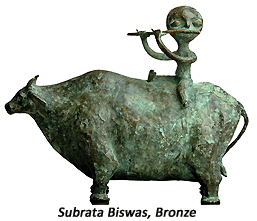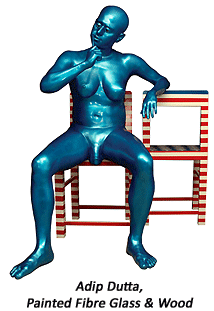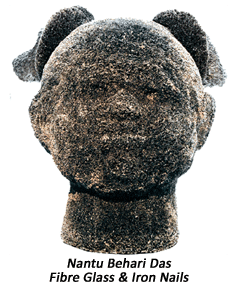- Prelude
- Editorial
- 'Public Sculptures are the Public's own Consciousness'
- Stimulating Thoughts
- Sculptural Traditions and Contemporary Art Practices
- Sculpting out a Third Dimension from Madhya Pradesh
- About Nostalgic Dragonflies and Homes in the Bags: Sculptural Snapshots from the North-East
- A Concise Chronicle of Bengal's Modern Sculpture
- Neo-sculptural Identity: Six Young Sculptors
- From Object to Experience: Notes on American Sculpture
- In the Domain of Drama Sculptures of S.Nandagopal
- Satish Gujral : Sculpting the Inner Form
- Transformation of Articulations: Mrinalini Mukherjee
- The Experiential Quotient in the Sculptures of Ravinder Reddy
- Shresta Rit Premnath A Passion for Structure
- The Anatomy of Melancholy: Sculptures of Rajesh P Subramanium
- A Crusader of/for Site Specific Public Art: Subodh Kerkar
- Installation Practices in and around Santiniketan
- A Wall is a Screen: A Promenade Film Street Performance
- Jaeger-LeCoultre An Overview
- Regency Style: Regency Furniture
- Designing the Streetscapes: Visual Elements of Pedestrian Corridors
- Sculpture Rules It All
- The Triumph of the Eternal
- Artist Index and Statistics- Anish Kapoor
- Auction Reports
- Musings from Chennai
- Art Bengaluru
- Art Events Kolkata: October-November 2010
- Mumbai Art Sighting
- An Evening of Interaction
- 6th Asian Museum Curators' Conference
- Swedish Art in India
- Couple of Difference : Recent sculptures of Karl Antao
- Previews
- In the News
- Sotheby's : Important Watches Geneva
ART news & views
Neo-sculptural Identity: Six Young Sculptors
Volume: 3 Issue No: 11 Month: 12 Year: 2010
by Sarmistha Maiti
|
“The twentieth century was marked by a new subjectivity of thought, and old paradigms gave way to new. Einstein's theory of relativity overthrew more static beliefs in physics. The atonalist musical composers overthrew the old common system alive for four hundred years and shifted aural attention away from the keynote and musical scale. Psychoanalytical thinkers continued to undermine confidence in conscious thought and reason.
- Excerpts from 1000 Sculptures of Genius
|
Artists have come across a long way in the process of making and breaking of subjectivity in the last century and especially sculpture has found its expression in the form of ephemera that are raised to the level of high art.  And in this way the found object of the early twentieth century in the sculpting art has been renewed in the art of contemporary installations in the late twentieth century and the early twenty-first century. In India, as in other parts of the world, the entire new generation of sculptors have re-invented the traditional sculpting trend and also led to the evolution of a neo-language that was quite alien in the Indian context.
And in this way the found object of the early twentieth century in the sculpting art has been renewed in the art of contemporary installations in the late twentieth century and the early twenty-first century. In India, as in other parts of the world, the entire new generation of sculptors have re-invented the traditional sculpting trend and also led to the evolution of a neo-language that was quite alien in the Indian context.
As Herbert Read comments, “…the modern period has seen the invention of three-dimensional works of art which are in no sense 'sculpted' or moulded. They are built up, like architecture, or constructed like a machine”. The passion behind sculpting motivated by the joy of procreation has revolutionized post-modern art in every sense. If we observe the tradition of image-making and now the latest trend of sculpting as one of the most innovative, conceptual and ideational discourses of aesthetics, it will be eminently noticeable that sculptors have remained engaged in experimenting with techniques, material and mediums at every moment of the execution of their art. But now with the ballyhoo of globalization, sculpting has become an amalgamation of various art forms defined and shaped by a much broader connotation and syntax totally new to the art world.
The new generation sculptors in Bengal on whom this essay will precisely concentrate also have essentially gone beyond conventions in the handling of material or medium. On the one hand, the conventional bronze, wood or terracotta, and on the other scrap and junk material are being used to generate fresh concepts by the young generation sculptors. It is in fact the birth of a new genre. The whole idea has changed from moulding, shaping and recreating a material to that of the material itself getting recreated in a piece of art. Diffusion of style and technique with a flare of innovative ideas where sculptures mark the unique confluence of tradition and modernity has become the hallmark of the sculpture of the present era.  This is the generation which, if not born out of the cyber revolution, has indeed been hugely influenced by the age of networking and digitization.
This is the generation which, if not born out of the cyber revolution, has indeed been hugely influenced by the age of networking and digitization.
Here are six young sculptors from Bengal who are being celebrated across the country for their discourse allowing the birth of a novel generation in sculptural art. They are Akhil Chandra Das, Subrata Biswas, Tapas Biswas, Nantu Behari Das, Adip Dutta and Debanjan Roy. All of them have formal education in Visual Arts from different art institutions and universities in the country.
These six sculptors share a convivial yet a contrasting platform. Among them a few believe in purity and perfection of form that is being created without concentrating on the original quality of the material being used. And the other few, without changing the original quality of the raw material, give a new form and content to what is being created. But despite the formal dichotomy between these two sectors of young sculptors, all of them possess a novelty in their ideation, thought-process, and an energy to change their creative discourse.
 As Akhil Chandra Das is more concerned in breeding purity and tranquility in the feel and realization of the content of the sculptures like the saintly figures with minute detailing of posture, the created form finally relates to the devising of the real essence though in the form of the inanimate sculpture. Akhil always puts effort to retain the organic quality of the subject. Akhil knows very well that what his viewers would prefer, and imparts a sentiment to his works that his audience invariably falls for.
As Akhil Chandra Das is more concerned in breeding purity and tranquility in the feel and realization of the content of the sculptures like the saintly figures with minute detailing of posture, the created form finally relates to the devising of the real essence though in the form of the inanimate sculpture. Akhil always puts effort to retain the organic quality of the subject. Akhil knows very well that what his viewers would prefer, and imparts a sentiment to his works that his audience invariably falls for.
The integrity of the raw material with its depth, hollowness, texture, lustre all matter a lot for an artist, especially for a sculpture like Akhil, who yearns to transform and transcend the material to a different level altogether. But at the same time, handling the same kind of material too gives a deep sense of oneness that is not at all nullifiable. So any kind of thought-process that searches for a relief immediately gets down to be identified through the material the artist is so accustomed with. It is obviously the artist's forte to be able to keep alive the essence of the same raw material over the years. Akhil himself puts it in a very spontaneous way regarding his unification with the material, and now he just cannot do without them. Well, Akhil welcomes experimentation but not at the cost of damaging the basic yardsticks he has been following in his artistic career. In the new generation art sculpting has undergone several changes, as the raw material itself has evolved as a sculpture since the artist decodes the basic quality of the material and associates with it a new denomination of signifier-signified relationship.  Akhil is not apathetic towards it, but has a certain kind of discomfort in at least appropriating it in his own works. Probably there lies the significance of the artist's individuality that evolves with time but does not imitate the trend of the hour.
Akhil is not apathetic towards it, but has a certain kind of discomfort in at least appropriating it in his own works. Probably there lies the significance of the artist's individuality that evolves with time but does not imitate the trend of the hour.
Tapas Biswas's journey in the exploration of metal casting is more experimental and tentative. He always engages himself in the creation of a volume. The opacity of the volume is diverted into wonderful hollowness where the eddy of energy that floats within the harmony of the structure attracts and builds a close association with the space and liveliness the particular work of art radiates for its audience. Metal becomes subjective in his works and he creates magic in the way he executes hollowness and gradually proceeds to the finest structure of concrete identity through different sculptural forms. The content devised by him leads the audience to a thought-provoking area where again and again he addresses the issues of refugee settlement, migration, and transformation of identities, eternity, solace and final release from the entrapment of the material world.
In case of Subrata Biswas,  his engrossing attitude towards formal pattern of casting bronze which conceptually deals with the tales from Indian mythology with a blend of folk culture must be reckoned with as a trendsetter in Indian art. The most intriguing aspect of his works is the engraving style he applies on wide bronze plates like the engraved seals of the ancient civilizations in his creations. Subrata draws us to the nostalgic world of his childhood, and in a very native as well as naïve style executes his works with eventual processing and tender touch. Agony and ecstasy walk hand in hand in his sculptures, and his childish being evolves in his works as we trace the journey of this artist over a decade.
his engrossing attitude towards formal pattern of casting bronze which conceptually deals with the tales from Indian mythology with a blend of folk culture must be reckoned with as a trendsetter in Indian art. The most intriguing aspect of his works is the engraving style he applies on wide bronze plates like the engraved seals of the ancient civilizations in his creations. Subrata draws us to the nostalgic world of his childhood, and in a very native as well as naïve style executes his works with eventual processing and tender touch. Agony and ecstasy walk hand in hand in his sculptures, and his childish being evolves in his works as we trace the journey of this artist over a decade.
Adip Dutta has transcended sexuality and sexual identity especially in the true nature of the body though his compositions that is confrontational and erotic. Adip is into installation art with sculpting format building statements on personal identity and desire merging with social and political state of being. He gives birth to human figures with radical plastic quality that are a rare combination of ardent intellectual concentration and physical action and manage to create a space that is copious in atmosphere and holds deeper inner significance.
Debanjan Roy also executes figures and in volume that are life-size both in realistic and semi-realistic trends. His exposition is minimalist yet carries weight in the conceptualization of the content, and in this rare combination he addresses the complex through a bewitching simplicity.
 Nantu Behari Das has given birth to a bigger difference from the existing set parameters of sculpture making. His work of art can be a gateway to theorize new generation sculpture of the contemporary context. Nantu has eventually allowed the raw material itself to evolve as a sculpture. In this process he has led to the decoding of the basic quality of the material and has given it a new identity of signifier-signified relationship. He does not imbibe the installation quality in any form. On the contrary, he sculpts in a symbolic way and conveys a different meaning where, through content, form and medium, he induces the viewers to reciprocate with his works through a cerebral journey. The mock element in his work is intense and he transposes his intended ideation with much conviction when he plays around with different material that have been at a far remove from the tradition of sculpture.
Nantu Behari Das has given birth to a bigger difference from the existing set parameters of sculpture making. His work of art can be a gateway to theorize new generation sculpture of the contemporary context. Nantu has eventually allowed the raw material itself to evolve as a sculpture. In this process he has led to the decoding of the basic quality of the material and has given it a new identity of signifier-signified relationship. He does not imbibe the installation quality in any form. On the contrary, he sculpts in a symbolic way and conveys a different meaning where, through content, form and medium, he induces the viewers to reciprocate with his works through a cerebral journey. The mock element in his work is intense and he transposes his intended ideation with much conviction when he plays around with different material that have been at a far remove from the tradition of sculpture.
The invariable dynamism and conceptualization in the working styles of new generation sculptures has promulgated a panorama of new ventures in the trend of modern sculpting. The novel challenges in vibrant thoughts of procreation do indicate the possibility of a new movement in the art of sculpting in totality. And the debate that sculptural ornamentation has disappeared to the detriment of society, and that the functional form leaves little room for sculptural ornamentation, will once again get the chance to be revised and revived in a new way with sensitive anecdotes and refined structures in the hands of the new generation sculptors. Bengal sculptors really stand as the initiators of an altogether new creative process!